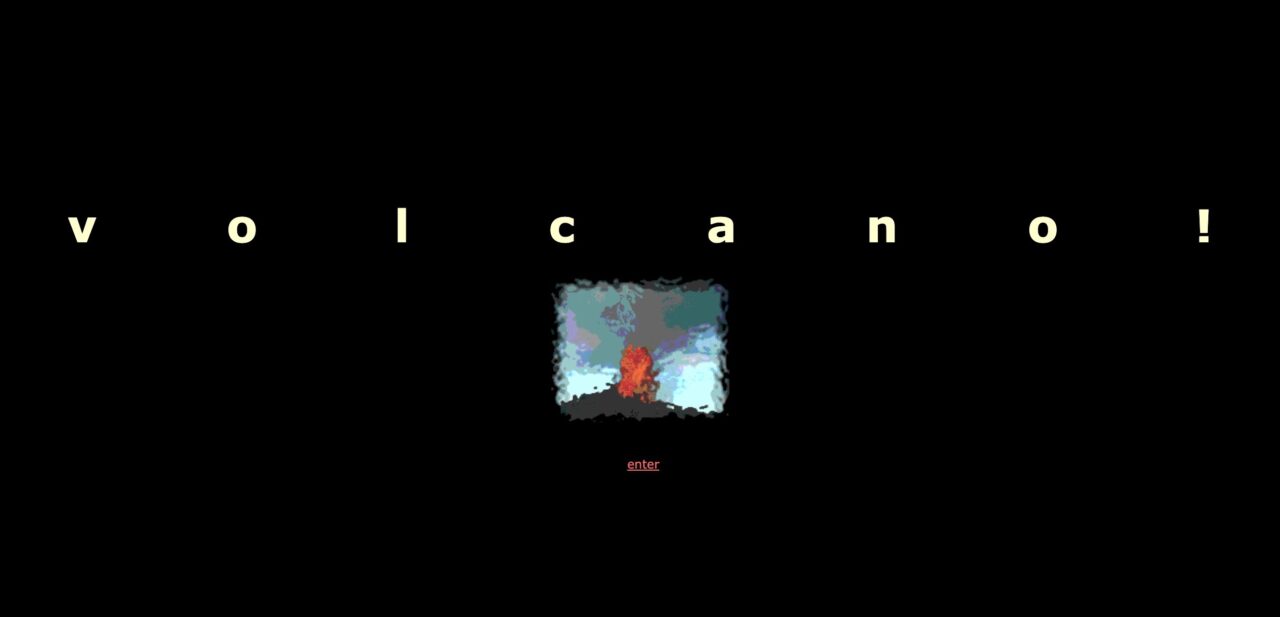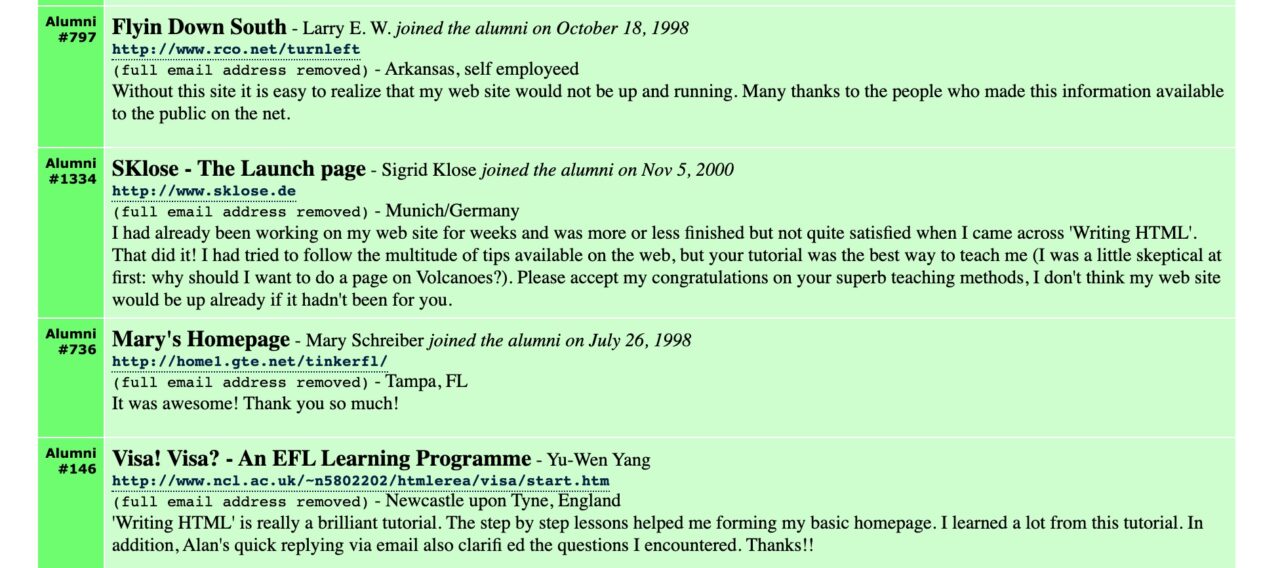According to the 25 of EdTech Years Goggles, 1994 was the year of BBS. The web itself came to be a thing in 1995. But you’ve heard it all, right?
My foray into what I might claim as an open course on the web has been dangling around that drafty place of drafts described by Stephen King in Night Shift as “grey matter” for a while, and now might even be classified as encrusted with mold.
The key learnings for me this web building experience included what seems insanely obvious now.
But then?
- Going beyond what I saw myself in what was passed off as tutorials that were merely technical reference guides, to create activities that built real content in a subject area, made a difference.
- By being in web format and made available from a web server, the same materials I created for a local workshop of maybe 7 participants could, without any, extra effort, be made freely, openly available to anyone else
- This opened the unexpected door of others who found these materials to make suggestions to improve them, and without prompting, to make translations of them into different languages
- When provided a means, those having a successful experience would share back their story.
- The things you do in online lessons should be fun, or at least interesting, or have some kind of personality/presence.
Somehow this happened without knowing this ahead of time.
One might cast WritingHTML as not much more than a technical how to tutorial, but it was for me, a first thing I crafted that caught on a bit, and spread, mutated on the web, and even has ripples still sitting out there (4700 Google Hit Points!).
It was never really a “course” per say, but it was a series of lessons, offered freely and openly online, that many people used, others remixed or added to it, and mostly, I was able to “teach” people I never met, knew, or knew I was teaching.
Long cut from its original home at it’s five dot subdomain depth at the Maricopa Community Colleges http://www.mcli.dist.maricopa.edu/tut/ has over 1300 snapshots in the Wayback machine between January 4, 1997 and May 25, 2015. I have all the source files, and have rebuilt much of what I can (still with many broken links) at https://mcli.cogdogblog.com/tut/

This stemmed from the potential of the web lit under my fire in 1993 as a way anyone could in theory create hyperlinked multimedia content, that was free of the problems of working on either Apple or Windows computer platforms. The web, HTML was universal. it still is.
I learned HTML from the NCSA tutorial, which sadly is not even findable at NCSA, with copies strewn about a number of web sites that are questionable for the long term. But like many things labeled as “tutorials” they were only pretty much a reference guide to the HTML tags. They were not structured as a something that might appeal to someone without a technical bent to begin with.
In WritingHTML, you worked towards building a final web site about Volcanoes (having just left graduate school in Geology, I leaned on a topic I had some knowledge of) that has all of the elements covered in the lessons, from the basic HTML, to multiple documents, media, animations, JavaScript, Java, Shockwave, the mid 1990s kitchen sink of the web (pre CSS).

Participants were welcome to either copy my instructions step by step, or do the same steps for their area of interest. Not everyone is into volcanoes.
Much of what made this work well I credit to Tom Super, an ASU instructional design who interned in our center. He helped craft a consistent structure, with objects at the front, and a check at the end that aligned with them, and also, on how much to segment the material.
The clever part of the design, was at the opening of each lesson, you could download all of the files needed to produce everything up to the preceding lesson (maybe if you had not followed everything exactly?)- so you could start from the same place the lesson expected. For example, in lesson 11 on Definition Lists (who uses them anymore?) you could download or check your work against all of the work leading up to this lesson. At the end of the lesson, under “Check Your Work” you could compare your work against what it should look like (this in turn is the basis for the download in the next lesson). All lessons included optional extra activities that built on the basics covered or additional information of interest.
I look now and see a lot of complexity in the later lessons on topic like using JavaScript to respond to web forms.
The first version of this tutorial was developed for a June 1, 1994 workshop at South Mountain Community College. I recall the maybe being 7? 10? participants in a small room in the SMCC Library. It covered the first 8 lessons, the basics of an HTML document, headings, paragraphs, styles (like bold and italic!), images, and hyperlinks.
For that workshop I ran all of the lessons from a local directory of web files, of which I gave copies to participants (perhaps on floppy disk or maybe I ran than from our center’s AppleShare server).
I know in the room was Philosophy teacher Mary Long, who also taught Psychology, Religious Studies, Sociology, & Cinema! Mary was already excited about the web, and she went on to build a resource site I housed on our server called The Source. Also present was LynnAnn Wojciechowicz who want on to lead the development of the South Mountain Community College Storytelling Institute, a project I later worked on too.
I kept a running history of changes as this matured from 1994 to 2000. By that time, with many people using authoring tools, LMSes, the interest in creating HTML from scratch was long peaked.
The things I was excited about was people asking to translate the tutorial. With all that structure inside, it was quite a huge task, but over time there were versions of WritingHTML in Spanish, French, Icelandic, Korean, Italian, and Japanese.
I built in over time different ways that I would know that people were using the tutorial. I thought I was clever in lesson 12 that showed how to make a hyperlink that could send an email, to have a sample link that emailed to me a message with a subject line “Hi from Lesson 12” — can you tell what an innocent era of internet this was?

I got thousands of messages, and for some time I had a system where I could parse them and share the text of the responses as a collection of “kudos” (this all got lost in the web wash). But I was getting individual messages from people I was “teaching” without ever having any contact or connection.
Another place on the site I had a form where people could fill out a form and register themselves as an “alumni”. I had this all rigged in a PHP script that would store the responses (again, naively in the 1990s as a writable text file, something one would never do now). These I was able to preserve (I just deleted all the personal email addresses that were saved in the original. You get 10 random responses at a time from over 1700 in total.
It’s a fun window into what people got out of this 1990s web learning.

Again, I shudder some at the complexity of my lessons. Was it something I wrote to my own level of understanding? Whomever would really want to write raw HTML and figure out media, JavaScript, etc?
On the other hand, this all still (mostly) runs now, 17 years later. That is what not only web code can do, but web code that I manage the publishing of. No one can ever take my work off the web, except for me.
So many things came from this experience beyond the old content itself. A favorite part of my connection with long time colleague and friend Brian Lamb, is his story of while teaching in Mexico, how he learned HTML from WritingHTML long before we actually even met. It was a long arc from that encounterless encounter that led to RSS+Blogs+Wikis, wearing aluminum foil hats at an Educause Conference session named after fish tacos, Northern Voice years, SPLOT time, and more than will fit in a blog post. Did an HTML tutorial cause this? Nah, but it’s part of the story.
But there was also the offer from an educator far away named Gudjon Olafsson to translate WritingHTML into Icelandic (he would share photos from his web cam sharing into his view of Isafjörður) a connection that led to him offering me a workshop trip for me to Reykjavik and an invite to visit his home in the Northwest corner of Iceland. Did this Amazing Story happen because of an HTML tutorial? Nah, but it’s part of the story.
And I have met many people over the years that mention learning HTML from “The Volcano thing.”
Course or not, this part of my journey, and it’s hard to believe how much came from a small start of an idea.
Updates
Featured Image: Composite of screenshots of the Writing HTML site, the final product of the tutorial, and a photo of me on my 2000 trip to Iceland.. All my stuff, license it do what ever you want with it.



Comments